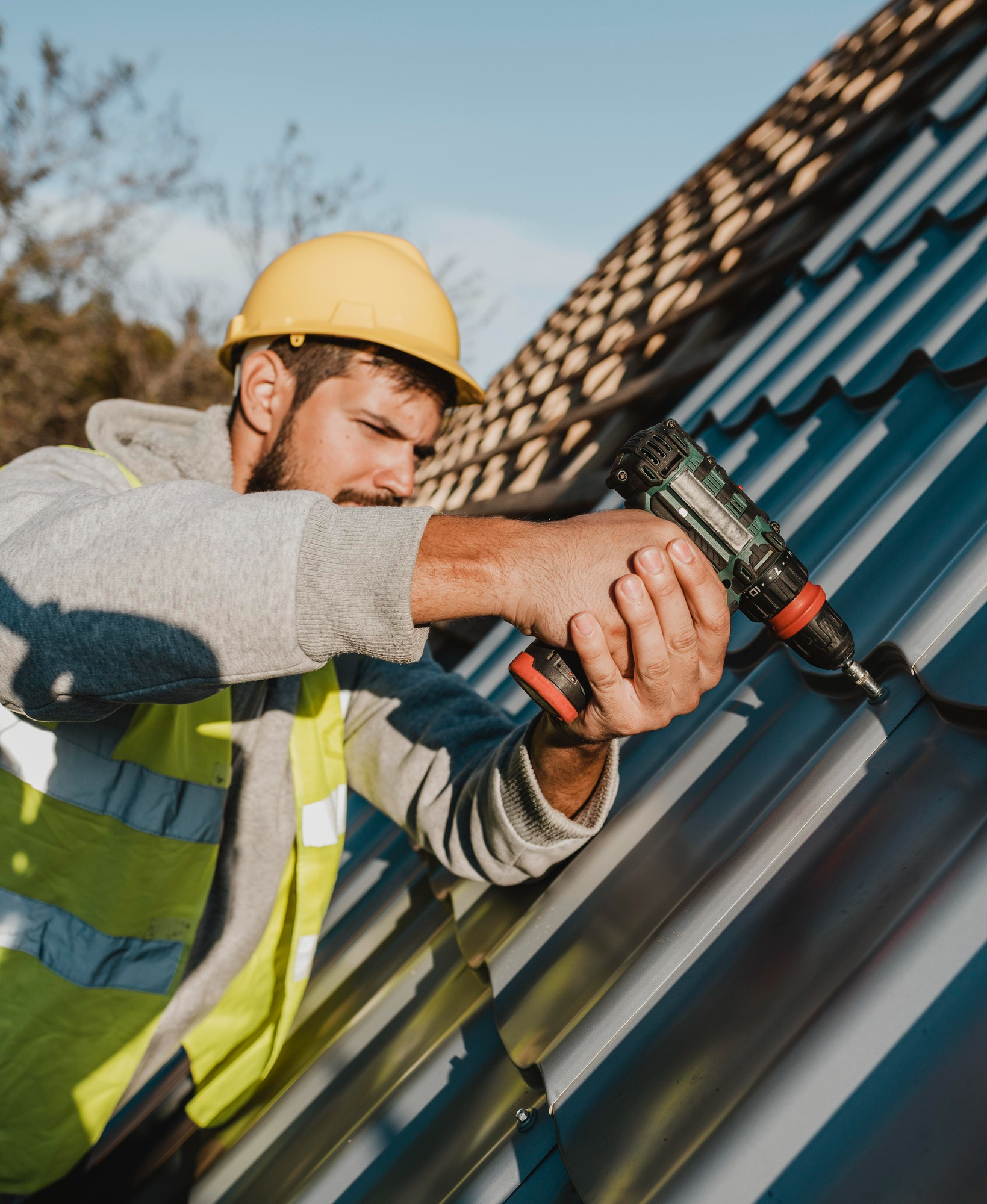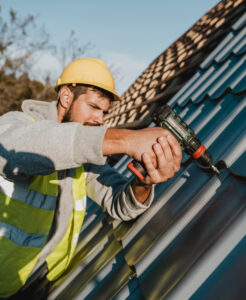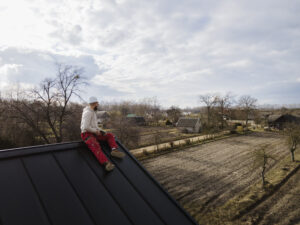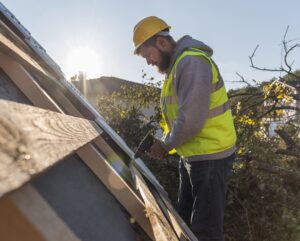Roof Replacement Tampa: Your Complete Guide to a Secure Home

Quick Summary / Key Takeaways
If you only remember 5 things from this guide, make it these:
- Roof replacement in Tampa protects your home from harsh weather, preventing costly damage.
- Understanding Tampa’s permitting process ensures a smooth and compliant roof replacement.
- Choosing the right roofing material, like tile or shingle, balances cost and longevity.
- Regular roof inspections can identify issues early, potentially avoiding full replacement.
- Hiring a licensed and insured Tampa roofing contractor guarantees quality workmanship and protection.
Roofing Material Comparison in Tampa
| Material | Lifespan | Cost (per sq ft) | Weather Resistance |
| Asphalt Shingles | 15-25 years | $3-5 | Moderate |
| Tile | 50-100 years | $10-20 | Excellent |
| Metal | 40-70 years | $8-15 | High |
| Wood Shakes | 20-40 years | $7-12 | Moderate (requires treatment) |
Tampa Roofing Contractor Features
| Feature | Licensed | Insured | Warranty | Local Reputation |
| Contractor A | Yes | Yes | 10 years | Excellent |
| Contractor B | Yes | No | 5 years | Good |
| Contractor C | No | No | N/A | Fair |
| Contractor D | Yes | Yes | 20 years | Very Good |
Launch Checklist
- Obtain necessary permits from the City of Tampa.
- Select a licensed and insured roofing contractor.
- Choose the appropriate roofing material for your needs and budget.
- Establish a clear contract outlining project scope and payment terms.
- Prepare your property by removing obstacles and protecting landscaping.
- Schedule the roof replacement during favorable weather conditions.
Follow-Up Checklist
- Inspect the completed roof for any defects or issues.
- Obtain all necessary documentation, including warranties and permits.
- Schedule a follow-up inspection to address any concerns.
- Maintain your roof with regular cleaning and minor repairs.
- Document the roof replacement for insurance and resale purposes.
- Consider a roof maintenance plan for long-term care.
Introduction
Replacing your roof in Tampa is a significant investment, protecting your home from Florida’s intense sun, heavy rains, and occasional storms. A well-maintained roof not only enhances curb appeal but also prevents costly water damage and energy loss. Understanding the process, from selecting the right materials to navigating local regulations, is crucial for a successful roof replacement project.
This guide provides comprehensive information on roof replacement in Tampa, covering material options, contractor selection, permitting requirements, and maintenance tips. We aim to empower you with the knowledge to make informed decisions and ensure a durable, reliable roof for years to come. Click here to begin your journey towards a secure and beautiful home.
By understanding the key factors involved in roof replacement, you can protect your investment and ensure your home remains safe and comfortable.
Table of Contents
SECTION 1: UNDERSTANDING ROOF REPLACEMENT NEEDS
- How do I know if I need a new roof?
- What are the common signs of roof damage in Tampa?
- How long does a typical roof last in Tampa’s climate?
- What factors affect roof lifespan in Tampa?
- Can I repair my roof, or is replacement necessary?
- What are the different types of roofing materials available in Tampa?
- What are the pros and cons of asphalt shingles?
- What are the benefits of tile roofing in Tampa?
SECTION 2: CHOOSING THE RIGHT ROOFING MATERIAL
- Is metal roofing a good option for Tampa homes?
- How does the cost of different roofing materials compare?
- How do I find a reputable roofing contractor in Tampa?
- What questions should I ask a roofing contractor?
SECTION 3: NAVIGATING THE ROOF REPLACEMENT PROCESS
- How do I get a roof replacement estimate?
- What does a roof replacement estimate include?
- How long does a roof replacement take?
SECTION 4: MAINTAINING YOUR NEW ROOF
- How do I maintain my new roof?
- How often should I inspect my roof?
- What are the common roof maintenance tasks?
- How do I clean my roof?
Frequently Asked Questions
Section 1: Understanding Roof Replacement Needs
FAQ 1: How do I know if I need a new roof?
You need a new roof if you notice significant damage such as leaks, missing or damaged shingles, excessive granule loss, or sagging. Other indicators include a roof that is nearing the end of its expected lifespan, typically 20-25 years for asphalt shingles. Visible signs of water damage inside your home, like ceiling stains or mold growth, also suggest a compromised roof. Consider a professional inspection to accurately assess the extent of the damage. Ignoring these signs can lead to more extensive and costly repairs. Tampa roof replacement is an investment.
Real Results: A homeowner in Tampa noticed water stains on their ceiling after a heavy rain. Upon inspection, the roofing contractor found extensive shingle damage and recommended a full roof replacement.
Takeaway:
Schedule a professional roof inspection if you suspect any issues to determine if replacement is necessary.
FAQ 2: What are the common signs of roof damage in Tampa?
Common signs of roof damage in Tampa include missing, cracked, or curled shingles, as well as granule loss, which appears as dark patches on the shingles. Leaks in the attic or water stains on ceilings and walls are also telltale signs. Moss or algae growth can trap moisture and damage the roofing material over time. Pay attention to any unusual sagging or dips in the roof’s surface, which may indicate structural problems.
Real Results: A Tampa homeowner experienced persistent leaks during the rainy season. An inspection revealed cracked tiles and deteriorated underlayment, necessitating a complete roof replacement.
Takeaway:
Regularly inspect your roof for these signs to catch problems early and prevent further damage.
FAQ 3: How long does a typical roof last in Tampa’s climate?
A typical roof in Tampa lasts between 15 to 25 years for asphalt shingles, while tile and metal roofs can last 50 years or more. The lifespan depends on the material, installation quality, and weather exposure. Tampa’s intense sun, humidity, and occasional storms can accelerate wear and tear. Regular maintenance, such as cleaning and minor repairs, can extend the roof’s lifespan. Choosing high-quality materials also improves longevity.
Real Results: A home built in 1998 with asphalt shingles required a roof replacement in 2023 due to the shingles deteriorating from the constant sun exposure.
Takeaway:
Consider the material’s lifespan and Tampa’s climate when selecting a roofing material.
FAQ 4: What factors affect roof lifespan in Tampa?
Several factors affect roof lifespan in Tampa, including the type of roofing material, quality of installation, and exposure to severe weather. Intense UV radiation from the sun degrades roofing materials over time. High humidity promotes algae and moss growth, which can trap moisture and cause damage. Strong winds and heavy rains from tropical storms can dislodge shingles or tiles. Proper ventilation can help regulate temperature and humidity, extending the roof’s lifespan.
Real Results: A metal roof installed with proper ventilation in a Tampa home lasted over 50 years, while a similar asphalt shingle roof needed replacement after only 20 years.
Takeaway:
Ensure proper installation and ventilation to maximize your roof’s lifespan in Tampa’s climate.
FAQ 5: Can I repair my roof, or is replacement necessary?
Whether to repair or replace your roof depends on the extent of the damage. Minor issues like a few missing shingles or small leaks can often be repaired. However, if the roof is old, has widespread damage, or has structural problems, replacement is usually the better option. A professional inspection can determine the most cost-effective solution. Replacing a severely damaged roof prevents further water damage and potential structural issues.
Real Results: A homeowner initially sought a roof repair for a small leak, but a thorough inspection revealed extensive rot and deterioration, leading to a full roof replacement recommendation.
Takeaway:
Get a professional assessment to determine if repair or replacement is the best course of action.
Section 2: Choosing the Right Roofing Material
FAQ 6: What are the different types of roofing materials available in Tampa?
Tampa homeowners have several roofing material options, including asphalt shingles, tile, metal, and wood shakes. Asphalt shingles are the most common due to their affordability and ease of installation. Tile roofs are durable and offer excellent weather resistance, making them popular in Florida. Metal roofs are long-lasting and energy-efficient, reflecting heat and reducing cooling costs. Wood shakes provide a natural, rustic look but require more maintenance.
Real Results: A homeowner switching from asphalt shingles to a tile roof saw a significant decrease in their home insurance premiums due to the tile’s superior durability.
Takeaway:
Consider the pros and cons of each material before making a decision based on your budget and needs.
FAQ 7: What are the pros and cons of asphalt shingles?
Asphalt shingles are affordable and easy to install, making them a popular choice for many homeowners. They come in various colors and styles, providing aesthetic flexibility. However, they have a shorter lifespan compared to other materials, typically lasting 15-25 years. They are also less resistant to extreme weather conditions like high winds and hail. Roof replacement costs vary. Asphalt shingles require more frequent maintenance than tile or metal roofs.
Real Results: A homeowner chose asphalt shingles for their rental property due to the lower upfront cost and ease of repair compared to other roofing materials.
Takeaway:
Asphalt shingles are a budget-friendly option but require more frequent replacement and maintenance.
FAQ 8: What are the benefits of tile roofing in Tampa?
Tile roofing offers exceptional durability and longevity, often lasting 50 years or more, and it’s particularly well-suited for Tampa’s climate, providing excellent resistance to heat, wind, and rain. Tile is also fire-resistant and requires minimal maintenance. It enhances a home’s aesthetic appeal, adding a touch of elegance and sophistication. While the initial cost is higher than asphalt shingles, the long lifespan and low maintenance make it a worthwhile investment.
Real Results: A homeowner with a tile roof reported significantly lower energy bills due to the tile’s excellent insulation properties, keeping their home cooler in the summer.
Takeaway:
Tile roofing is a durable and long-lasting option that can enhance your home’s value and energy efficiency.
FAQ 9: Is metal roofing a good option for Tampa homes?
Metal roofing is an excellent option for Tampa homes due to its durability, energy efficiency, and resistance to extreme weather. Metal roofs can last 40-70 years, making them a long-term investment. They reflect sunlight, reducing cooling costs and improving energy efficiency. Metal is also fire-resistant and can withstand high winds and heavy rains. While the initial cost may be higher than asphalt shingles, the long lifespan and energy savings make it a cost-effective choice.
Real Results: A homeowner who switched to a metal roof saw a 30% reduction in their energy bills during the summer months, thanks to the metal’s reflective properties.
Takeaway:
Metal roofing is a durable, energy-efficient option that can save you money in the long run.
FAQ 10: How does the cost of different roofing materials compare?
The cost of roofing materials varies significantly, with asphalt shingles being the most affordable option, typically costing $3-5 per square foot. Tile and metal roofs are more expensive, ranging from $8-20 per square foot. Wood shakes fall in between, costing around $7-12 per square foot. These prices include the cost of materials and installation. Consider the long-term cost savings from durability and energy efficiency when comparing materials.
Real Results: A homeowner chose asphalt shingles for their budget-friendly price, but planned to upgrade to metal roofing in the future for its long-term benefits.
Takeaway:
Compare the upfront cost with the long-term benefits when choosing a roofing material.
Section 3: Navigating the Roof Replacement Process
FAQ 11: How do I find a reputable roofing contractor in Tampa?
Finding a reputable roofing contractor in Tampa involves researching local companies, checking online reviews, and verifying licenses and insurance. Ask for referrals from friends, family, or neighbors. Look for contractors with a proven track record of quality workmanship and customer satisfaction. Obtain multiple estimates to compare prices and services. Ensure the contractor is licensed and insured to protect yourself from liability. Click here to find a trusted contractor.
Real Results: A homeowner used online reviews and referrals to find a roofing contractor with excellent ratings and a history of successful roof replacements in their neighborhood.
Takeaway:
Thoroughly research and verify the credentials of any roofing contractor you consider hiring.
FAQ 12: What questions should I ask a roofing contractor?
When interviewing roofing contractors, ask about their experience, licensing, and insurance coverage. Inquire about the types of roofing materials they work with and their preferred installation methods. Ask for references from previous clients and examples of their work. Clarify the project timeline, payment terms, and warranty coverage. Ensure the contractor understands local building codes and permitting requirements.
Real Results: A homeowner asked potential contractors about their experience with tile roofing and chose the one with the most extensive portfolio of successful tile roof installations.
Takeaway:
Prepare a list of questions to ensure the contractor is qualified and meets your needs.
FAQ 13: How do I get a roof replacement estimate?
To get a roof replacement estimate, contact several roofing contractors and schedule on-site inspections. Provide them with details about your roof’s size, type, and any existing damage. The contractor will assess the condition of your roof and provide a detailed estimate, including the cost of materials, labor, and permits. Compare multiple estimates to ensure you are getting a fair price. Ensure the estimate is comprehensive and includes all potential costs.
Real Results: A homeowner obtained three different estimates for their roof replacement, ranging from $10,000 to $15,000, allowing them to negotiate a better price with their chosen contractor.
Takeaway:
Obtain multiple estimates to compare prices and ensure you are getting a fair deal.
FAQ 14: What does a roof replacement estimate include?
A roof replacement estimate should include a detailed breakdown of all costs, including materials, labor, permits, and disposal fees. It should specify the type and quantity of roofing materials to be used. The estimate should also outline the scope of work, including the removal of the old roof, installation of underlayment, and installation of the new roofing material. Ensure the estimate includes a timeline for the project’s completion. Review all estimate line items carefully before agreeing to the work.
Real Results: A homeowner reviewed their roof replacement estimate and noticed a discrepancy in the quantity of shingles listed, allowing them to correct the error before the project began.
Takeaway:
Carefully review all line items in the estimate to ensure accuracy and completeness.
FAQ 15: How long does a roof replacement take?
A typical roof replacement in Tampa takes between 1 to 5 days, depending on the size and complexity of the roof, as well as the weather conditions. Simple asphalt shingle roofs can often be completed in 1-2 days. More complex roofs, such as those with multiple layers or intricate designs, may take longer. Unfavorable weather, such as rain or high winds, can also delay the project. A roofing contractor can provide a more accurate timeline based on your specific situation.
Real Results: A homeowner was informed that their roof replacement would take three days, but it was completed in two due to favorable weather conditions and efficient teamwork.
Takeaway:
Factor in potential delays due to weather and roof complexity when planning your roof replacement.
Section 4: Maintaining Your New Roof
FAQ 16: How do I maintain my new roof?
Maintaining your new roof involves regular inspections, cleaning, and minor repairs. Inspect your roof at least twice a year, looking for missing or damaged shingles, cracks, or signs of water damage. Clean your roof to remove debris, moss, or algae growth. Trim overhanging tree branches to prevent damage. Address any minor repairs promptly to prevent further deterioration. Consider a professional roof maintenance plan for comprehensive care.
Real Results: A homeowner who regularly cleaned their roof and trimmed overhanging branches extended its lifespan by several years, avoiding costly repairs.
Takeaway:
Regular maintenance can significantly extend the life of your roof and prevent costly repairs.
FAQ 17: How often should I inspect my roof?
You should inspect your roof at least twice a year, typically in the spring and fall. Additional inspections are recommended after severe weather events, such as hurricanes or heavy storms. Look for any signs of damage, such as missing or cracked shingles, leaks, or granule loss. Early detection of problems can prevent further damage and costly repairs. A professional inspection can provide a more thorough assessment.
Real Results: A homeowner who inspected their roof after a hurricane discovered several missing shingles, allowing them to repair the damage before it led to a leak.
Takeaway:
Regular inspections, especially after severe weather, can help identify and address potential problems early.
FAQ 18: What are the common roof maintenance tasks?
Common roof maintenance tasks include cleaning debris, removing moss and algae, trimming overhanging branches, and repairing minor damage. Remove leaves, twigs, and other debris from your roof to prevent moisture buildup. Apply a moss or algae treatment to prevent growth. Trim overhanging branches to prevent them from scratching or damaging the roof. Repair any missing or damaged shingles promptly. These tasks help maintain the integrity and extend the lifespan of your roof.
Real Results: A homeowner who regularly cleaned debris from their roof prevented moisture buildup and extended its lifespan by several years.
Takeaway:
Perform these common maintenance tasks to keep your roof in good condition.
FAQ 19: How do I clean my roof?
To clean your roof, use a soft brush or broom to remove loose debris, such as leaves and twigs. You can also use a garden hose with a low-pressure nozzle to rinse the roof. Avoid using high-pressure washers, as they can damage the roofing material. For stubborn stains or moss growth, apply a specialized roof cleaning solution. Always follow the manufacturer’s instructions and take safety precautions to prevent falls. Professional roof cleaning services are also available.
Real Results: A homeowner used a soft brush and garden hose to remove debris from their roof, preventing moisture buildup and extending its lifespan.
Takeaway:
Clean your roof regularly using gentle methods to avoid damage and maintain its appearance.
Recent Post

Roof Replacement Tampa: Your Complete Guide to a Secure Home

St. Petersburg, FL Roofing: Your Expert Guide





